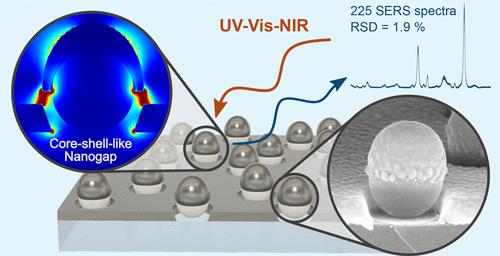纳米间隙工程的核壳状纳米结构用于综合SERS分析
IF 8.2
2区 材料科学
Q1 MATERIALS SCIENCE, MULTIDISCIPLINARY
引用次数: 0
摘要
开发具有空间控制分布的小于10nm间隙的大面积等离子体纳米结构的制造方案对于其实际应用至关重要。在这项工作中,我们开发了一种简单的,无尘室的方案,用于制造宏观尺寸的等离子体衬底(>6 cm2),具有可调的多共振光学响应和光浓度在10 nm以下的间隙。关键是,这些间隙可以自由地与周围介质相互作用。该结构由非周期性分布的介质纳米球包覆一层金属多层膜,形成被平面膜包围的半球形核壳状纳米结构(csln)。通过调整制造参数,如多金属层厚度、成分或纳米球的尺寸和密度,可以很容易地调整金属帽与平面薄膜之间形成的低于10 nm的间隙。csln基板具有优异的结构均匀性、广泛的光学可调性和空间控制亚波长纳米隙中的极端光约束,使其成为综合表面增强拉曼散射(SERS)光谱的理想平台。通过数值模拟和迭代制作/表征相结合的方法证明了这一点,优化后的衬底具有先进的空间均匀性,其空间均匀性可达1.9%,这是由对巯基苯甲酸在3600 μm2面积上225个光谱的SERS信号的相对标准偏差(RSD)确定的。高灵敏度的增强因子为~ 10.6,所提出的底物也满足所有其他要求的标准,包括足够的信号时间稳定性(RSD <4%),底物到底物的高再现性(<15%),以及对三种不同分析物的SERS活性。CSLN衬底独特的几何形状和宽光谱可调性也将对其他等离子体驱动的应用具有重要价值。本文章由计算机程序翻译,如有差异,请以英文原文为准。

Nanogap-Engineered Core–Shell-Like Nanostructures for Comprehensive SERS Analysis
Development of fabrication protocols for large-area plasmonic nanostructures with sub-10 nm gaps with a spatially controlled distribution is critical for their real-world applications. In this work, we develop a simple, cleanroom-free protocol for the fabrication of macroscopic-sized plasmonic substrates (>6 cm2), featuring a tunable multiresonance optical response and light concentration in sub-10 nm gaps. Critically, these gaps are free to interact with the surrounding medium. This architecture consists of nonperiodically distributed dielectric nanospheres coated with a metal multilayer, forming semispherical core–shell-like nanostructures (CSLNs) surrounded by a planar film. The sub-10 nm gaps formed between metal caps and the planar film are easily tuned by adjusting fabrication parameters, such as multimetal layer thickness, composition, or nanosphere size and density. The excellent structural homogeneity, wide optical tunability, and extreme light confinement in the spatially controlled subwavelength nanogaps make CSLN-based substrates an ideal platform for comprehensive surface-enhanced Raman scattering (SERS) spectroscopy. This is proven through a combination of numerical modeling and iterative fabrication/characterization, leading to the optimized substrates showing cutting-edge spatial uniformity down to 1.9% determined as the relative standard deviation (RSD) of the SERS signal of p-mercaptobenzoic acid for 225 spectra over the 3600 μm2 area. High sensitivity is evidenced by an enhancement factor of ∼10.6 The proposed substrates also meet all other demanding criteria, including sufficient signal temporal stability (RSD <4%), high substrate-to-substrate reproducibility (<15%), and SERS activity toward three various analytes. The unique geometry and wide spectral tunability of the CSLN substrates will also be of great value for other plasmon-driven applications.
求助全文
通过发布文献求助,成功后即可免费获取论文全文。
去求助
来源期刊

ACS Applied Materials & Interfaces
工程技术-材料科学:综合
CiteScore
16.00
自引率
6.30%
发文量
4978
审稿时长
1.8 months
期刊介绍:
ACS Applied Materials & Interfaces is a leading interdisciplinary journal that brings together chemists, engineers, physicists, and biologists to explore the development and utilization of newly-discovered materials and interfacial processes for specific applications. Our journal has experienced remarkable growth since its establishment in 2009, both in terms of the number of articles published and the impact of the research showcased. We are proud to foster a truly global community, with the majority of published articles originating from outside the United States, reflecting the rapid growth of applied research worldwide.
 求助内容:
求助内容: 应助结果提醒方式:
应助结果提醒方式:


